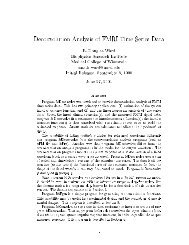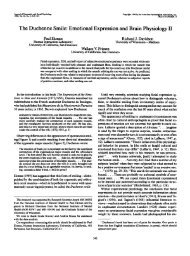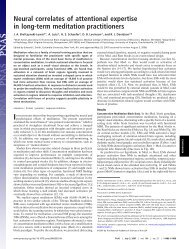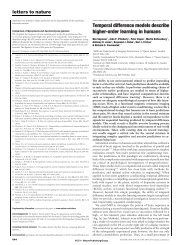l1-magic : Recovery of Sparse Signals via Convex Programming
l1-magic : Recovery of Sparse Signals via Convex Programming
l1-magic : Recovery of Sparse Signals via Convex Programming
Create successful ePaper yourself
Turn your PDF publications into a flip-book with our unique Google optimized e-Paper software.
Appendix<br />
A<br />
l 1 minimization with equality constraints<br />
When x, A and b are real, then (P 1 ) can be recast as the linear program<br />
∑<br />
min u i subject to x i − u i ≤ 0<br />
x,u<br />
i<br />
−x i − u i ≤ 0,<br />
Ax = b<br />
which can be solved using the standard primal-dual algorithm outlined in Section 2.1 (again,<br />
see [2, Chap.11] for a full discussion). Set<br />
f u1;i := x i − u i<br />
f u2;i := −x i − u i ,<br />
with λ u1;i, λ u2;i the corresponding dual variables, and let f u1 be the vector (f u1;1 . . . f u1;N ) T<br />
(and likewise for f u2 , λ u1 , λ u2 ). Note that<br />
( )<br />
δi<br />
∇f u1;i = ,<br />
−δ i<br />
( ) −δi<br />
∇f u2;i = ,<br />
−δ i<br />
∇ 2 f u1;i = 0, ∇ 2 f u2;i = 0,<br />
where δ i is the standard basis vector for component i. Thus at a point (x, u; v, λ u1 , λ u2 ), the<br />
central and dual residuals are<br />
( ) −Λu1 f<br />
r cent =<br />
u1<br />
− (1/τ)1,<br />
−Λ u2 f u2<br />
( )<br />
λu1 − λ<br />
r dual =<br />
u2 + A T v<br />
,<br />
1 − λ u1 − λ u2<br />
and the Newton step (5) is given by:<br />
⎛<br />
⎝ Σ ⎞ ⎛<br />
1 Σ 2 A T<br />
Σ 2 Σ 1 0 ⎠ ⎝ ∆x ⎞ ⎛<br />
∆u⎠ = ⎝ w ⎞ ⎛<br />
⎞<br />
−1<br />
1 (−1/τ) · (−fu 1<br />
+ fu −1<br />
2<br />
) − A T v<br />
w 2<br />
⎠ := ⎝ −1 − (1/τ) · (fu −1<br />
1<br />
+ fu −1<br />
2<br />
) ⎠ ,<br />
A 0 0 ∆v w 3 b − Ax<br />
with<br />
Σ 1 = Λ u1 F −1<br />
u 1<br />
− Λ u2 Fu −1<br />
2<br />
, Σ 2 = Λ u1 Fu −1<br />
1<br />
+ Λ u2 Fu −1<br />
2<br />
,<br />
(The F • , for example, are diagonal matrices with (F • ) ii = f •;i , and f −1<br />
•;i<br />
we can eliminate<br />
and solve<br />
Σ x = Σ 1 − Σ 2 2Σ −1<br />
1 ,<br />
∆x = Σ −1<br />
x (w 1 − Σ 2 Σ −1<br />
1 w 2 − A T ∆v)<br />
∆u = Σ −1<br />
1 (w 2 − Σ 2 ∆x),<br />
−AΣ −1<br />
1 AT ∆v = w 3 − A(Σ −1<br />
x w 1 − Σ −1<br />
x Σ 2 Σ −1<br />
1 w 2).<br />
= 1/f •;i.) Setting<br />
This is a K×K positive definite system <strong>of</strong> equations, and can be solved using conjugate gradients.<br />
Given ∆x, ∆u, ∆v, we calculate the change in the inequality dual variables as in (4):<br />
∆λ u1 = Λ u1 Fu −1<br />
1<br />
(−∆x + ∆u) − λ u1 − (1/τ)fu −1<br />
1<br />
∆λ u2 = Λ u2 Fu −1<br />
2<br />
(∆x + ∆u) − λ u2 − (1/τ)fu −1<br />
2<br />
.<br />
12




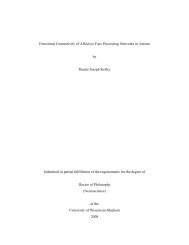
![[F-18]-L-DOPA PET scan shows loss of dopaminergic neurons](https://img.yumpu.com/41721684/1/190x146/f-18-l-dopa-pet-scan-shows-loss-of-dopaminergic-neurons.jpg?quality=85)
